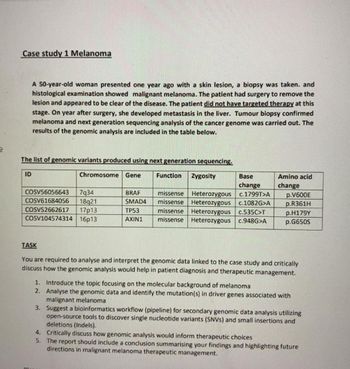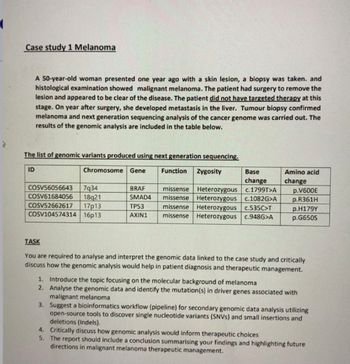
Human Anatomy & Physiology (11th Edition)
11th Edition
ISBN: 9780134580999
Author: Elaine N. Marieb, Katja N. Hoehn
Publisher: PEARSON
expand_more
expand_more
format_list_bulleted
Question

Transcribed Image Text:Case study 1 Melanoma
A 50-year-old woman presented one year ago with a skin lesion, a biopsy was taken. and
histological examination showed malignant melanoma. The patient had surgery to remove the
lesion and appeared to be clear of the disease. The patient did not have targeted therapy at this
stage. On year after surgery, she developed metastasis in the liver. Tumour biopsy confirmed
melanoma and next generation sequencing analysis of the cancer genome was carried out. The
results of the genomic analysis are included in the table below.
The list of genomic variants produced using next generation sequencing.
Chromosome Gene
Function Zygosity
ID
COSV56056643 7934
COSV61684056 18921
COSV52662617 17p13
COSV104574314 16p13
BRAF
SMAD4
TP53
AXIN1
Base
change
missense Heterozygous c.1799T>A
missense Heterozygous c.1082G>A
missense Heterozygous c.535C>T
missense Heterozygous c.948G>A
Amino acid
change
p.V600E
p.R361H
p.H179Y
p.G650S
TASK
You are required to analyse and interpret the genomic data linked to the case study and critically
discuss how the genomic analysis would help in patient diagnosis and therapeutic management.
1. Introduce the topic focusing on the molecular background of melanoma
2. Analyse the genomic data and identify the mutation(s) in driver genes associated with
malignant melanoma
3. Suggest a bioinformatics workflow (pipeline) for secondary genomic data analysis utilizing
open-source tools to discover single nucleotide variants (SNVS) and small insertions and
deletions (Indels).
4.
Critically discuss how genomic analysis would inform therapeutic choices
5. The report should include a conclusion summarising your findings and highlighting future
directions in malignant melanoma therapeutic management.
Expert Solution
This question has been solved!
Explore an expertly crafted, step-by-step solution for a thorough understanding of key concepts.
This is a popular solution
Trending nowThis is a popular solution!
Step by stepSolved in 2 steps

Follow-up Questions
Read through expert solutions to related follow-up questions below.
Follow-up Question
I am confused about questions 2 and 3, especially 3, can someone help

Transcribed Image Text:(
Case study 1 Melanoma
A 50-year-old woman presented one year ago with a skin lesion, a biopsy was taken. and
histological examination showed malignant melanoma. The patient had surgery to remove the
lesion and appeared to be clear of the disease. The patient did not have targeted therapy at this
stage. On year after surgery, she developed metastasis in the liver. Tumour biopsy confirmed
melanoma and next generation sequencing analysis of the cancer genome was carried out. The
results of the genomic analysis are included in the table below.
The list of genomic variants produced using next generation sequencing.
ID
Chromosome Gene
COSV56056643 7934
COSV61684056 18921
COSV52662617 17p13
COSV104574314 16p13
BRAF
SMAD4
TP53
AXIN1
Base
change
missense Heterozygous c.1799T>A
missense Heterozygous c.1082G>A
missense Heterozygous c.535C>T
missense Heterozygous c.948G>A
Function Zygosity
Amino acid
change
p.V600E
p.R361H
p.H179Y
p.G650S
TASK
You are required to analyse and interpret the genomic data linked to the case study and critically
discuss how the genomic analysis would help in patient diagnosis and therapeutic management.
1. Introduce the topic focusing on the molecular background of melanoma
2. Analyse the genomic data and identify the mutation(s) in driver genes associated with
malignant melanoma
3. Suggest a bioinformatics workflow (pipeline) for secondary genomic data analysis utilizing
open-source tools to discover single nucleotide variants (SNVS) and small insertions and
deletions (Indels).
4. Critically discuss how genomic analysis would inform therapeutic choices
5. The report should include a conclusion summarising your findings and highlighting future
directions in malignant melanoma therapeutic management.
Solution
by Bartleby Expert
Follow-up Questions
Read through expert solutions to related follow-up questions below.
Follow-up Question
I am confused about questions 2 and 3, especially 3, can someone help

Transcribed Image Text:(
Case study 1 Melanoma
A 50-year-old woman presented one year ago with a skin lesion, a biopsy was taken. and
histological examination showed malignant melanoma. The patient had surgery to remove the
lesion and appeared to be clear of the disease. The patient did not have targeted therapy at this
stage. On year after surgery, she developed metastasis in the liver. Tumour biopsy confirmed
melanoma and next generation sequencing analysis of the cancer genome was carried out. The
results of the genomic analysis are included in the table below.
The list of genomic variants produced using next generation sequencing.
ID
Chromosome Gene
COSV56056643 7934
COSV61684056 18921
COSV52662617 17p13
COSV104574314 16p13
BRAF
SMAD4
TP53
AXIN1
Base
change
missense Heterozygous c.1799T>A
missense Heterozygous c.1082G>A
missense Heterozygous c.535C>T
missense Heterozygous c.948G>A
Function Zygosity
Amino acid
change
p.V600E
p.R361H
p.H179Y
p.G650S
TASK
You are required to analyse and interpret the genomic data linked to the case study and critically
discuss how the genomic analysis would help in patient diagnosis and therapeutic management.
1. Introduce the topic focusing on the molecular background of melanoma
2. Analyse the genomic data and identify the mutation(s) in driver genes associated with
malignant melanoma
3. Suggest a bioinformatics workflow (pipeline) for secondary genomic data analysis utilizing
open-source tools to discover single nucleotide variants (SNVS) and small insertions and
deletions (Indels).
4. Critically discuss how genomic analysis would inform therapeutic choices
5. The report should include a conclusion summarising your findings and highlighting future
directions in malignant melanoma therapeutic management.
Solution
by Bartleby Expert
Knowledge Booster
Learn more about
Need a deep-dive on the concept behind this application? Look no further. Learn more about this topic, biology and related others by exploring similar questions and additional content below.Similar questions
- uestion 1 Match the meanings with their correct terms. low levels of blood sugar treatment of the mind study of tumors excision of the stomach pertaining to producing cancer abnormal condition (slight increase) of white blood cells brain disease abnormal condition of the skin cancerous condition of white blood cells pertaining to produced by treatment A. dermatosis B. hypoglycemia C. leukocytosis D. iatrogenic E. encephalopathy F. oncology G. gastric resection H. psychiatry I. leukemia J. carcinogenicarrow_forwardMatch the potential therapeutic to the primary stage of prostate cancer the drug would target Anticoagulant Answer 1 Drug inhibiting production of osteoblasts Answer 2 HIFalpha inhibitor Answer 3 Protease inhibitor Answer 4arrow_forwardGive typed explanation Case Study A 25-year-old male patient reports “itching all over my body” and is seeking treatment for the condition. Upon assessment, the nurse notes reddened areas on the patient’s arms, chest, and upper legs. The patient reports that this reddening is from scratching for the last 3 days. The patient reports intense itching around the undergarments as well. There is no apparent evidence of breaks in the skin, welts, pustules, or insect bites on the patient’s skin. The area around the patient’s undergarments appears chaffed, but no raised areas, open areas, or drainage are noted. The patient scratches around the undergarments but over the clothing, which has protected the skin from scratch marks. The patient’s back also appears chaffed. The patient reports a history of environmental allergies with nasal symptoms due to pollens and pet dander. The patient reports no recent change in prescribed medications, no use of supplements, and no use of new lotions or…arrow_forward
- Explain the mechanism of these in cancer treatment, all details needed. no details no rate.arrow_forwardAccording to the American Cancer Society, colon cancer screening should begin at age 50 for people at average risk. Imagine you have a family history of colon cancer. From your research, with reasons which procedures would your physician order for you and at what age ?arrow_forwardCase Study #6: A 20 year old male college student develops a fever after gall bladder surgery and has a pus exudate around the incision. You receive a cotton swab of the exudate which you streak on a blood agar plate. Bacterial colonies on the plate show B hemolysis, and microscopic examination reveals Gram + cocci occurring singly, in pairs, and in short chains. Further testing reveals that the isolate is catalase negative and phenol red fermentation broth with mannitol turns yellow. 1. What is the name of the most likely bacterium causing this infection? 2. What is the most likely place that this bacterium originated to cause this infection?arrow_forward
arrow_back_ios
arrow_forward_ios
Recommended textbooks for you
 Human Anatomy & Physiology (11th Edition)BiologyISBN:9780134580999Author:Elaine N. Marieb, Katja N. HoehnPublisher:PEARSON
Human Anatomy & Physiology (11th Edition)BiologyISBN:9780134580999Author:Elaine N. Marieb, Katja N. HoehnPublisher:PEARSON Biology 2eBiologyISBN:9781947172517Author:Matthew Douglas, Jung Choi, Mary Ann ClarkPublisher:OpenStax
Biology 2eBiologyISBN:9781947172517Author:Matthew Douglas, Jung Choi, Mary Ann ClarkPublisher:OpenStax Anatomy & PhysiologyBiologyISBN:9781259398629Author:McKinley, Michael P., O'loughlin, Valerie Dean, Bidle, Theresa StouterPublisher:Mcgraw Hill Education,
Anatomy & PhysiologyBiologyISBN:9781259398629Author:McKinley, Michael P., O'loughlin, Valerie Dean, Bidle, Theresa StouterPublisher:Mcgraw Hill Education, Molecular Biology of the Cell (Sixth Edition)BiologyISBN:9780815344322Author:Bruce Alberts, Alexander D. Johnson, Julian Lewis, David Morgan, Martin Raff, Keith Roberts, Peter WalterPublisher:W. W. Norton & Company
Molecular Biology of the Cell (Sixth Edition)BiologyISBN:9780815344322Author:Bruce Alberts, Alexander D. Johnson, Julian Lewis, David Morgan, Martin Raff, Keith Roberts, Peter WalterPublisher:W. W. Norton & Company Laboratory Manual For Human Anatomy & PhysiologyBiologyISBN:9781260159363Author:Martin, Terry R., Prentice-craver, CynthiaPublisher:McGraw-Hill Publishing Co.
Laboratory Manual For Human Anatomy & PhysiologyBiologyISBN:9781260159363Author:Martin, Terry R., Prentice-craver, CynthiaPublisher:McGraw-Hill Publishing Co. Inquiry Into Life (16th Edition)BiologyISBN:9781260231700Author:Sylvia S. Mader, Michael WindelspechtPublisher:McGraw Hill Education
Inquiry Into Life (16th Edition)BiologyISBN:9781260231700Author:Sylvia S. Mader, Michael WindelspechtPublisher:McGraw Hill Education

Human Anatomy & Physiology (11th Edition)
Biology
ISBN:9780134580999
Author:Elaine N. Marieb, Katja N. Hoehn
Publisher:PEARSON

Biology 2e
Biology
ISBN:9781947172517
Author:Matthew Douglas, Jung Choi, Mary Ann Clark
Publisher:OpenStax

Anatomy & Physiology
Biology
ISBN:9781259398629
Author:McKinley, Michael P., O'loughlin, Valerie Dean, Bidle, Theresa Stouter
Publisher:Mcgraw Hill Education,

Molecular Biology of the Cell (Sixth Edition)
Biology
ISBN:9780815344322
Author:Bruce Alberts, Alexander D. Johnson, Julian Lewis, David Morgan, Martin Raff, Keith Roberts, Peter Walter
Publisher:W. W. Norton & Company

Laboratory Manual For Human Anatomy & Physiology
Biology
ISBN:9781260159363
Author:Martin, Terry R., Prentice-craver, Cynthia
Publisher:McGraw-Hill Publishing Co.

Inquiry Into Life (16th Edition)
Biology
ISBN:9781260231700
Author:Sylvia S. Mader, Michael Windelspecht
Publisher:McGraw Hill Education